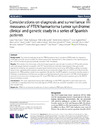Identificador persistente para citar o vincular este elemento:
https://accedacris.ulpgc.es/jspui/handle/10553/114194
| Título: | Considerations on diagnosis and surveillance measures of PTEN hamartoma tumor syndrome: clinical and genetic study in a series of Spanish patients | Autores/as: | Pena-Couso, L Ercibengoa, M Mercadillo, F Gomez-Sanchez, D Inglada-Perez, L Santos, M Lanillos, J Gutierrez-Abad, D Hernandez, A Carbonell, P Leton, R Robledo, M Rodriguez-Antona, C Perea, J Urioste, M Boronat, Mauro |
Clasificación UNESCO: | 32 Ciencias médicas 3201 Ciencias clínicas |
Palabras clave: | PTEN hamartoma tumor syndrome Cowden syndrome PTEN gene NGS Exome |
Fecha de publicación: | 2022 | Publicación seriada: | Orphanet Journal of Rare Diseases | Resumen: | Background: The limited knowledge about the PTEN hamartoma tumor syndrome (PHTS) makes its diagnosis a challenging task. We aimed to define the clinical and genetic characteristics of this syndrome in the Spanish population and to identify new genes potentially associated with the disease. Results: We reviewed the clinical data collected through a specific questionnaire in a series of 145 Spanish patients with a phenotypic features compatible with PHTS and performed molecular characterization through several approaches including next generation sequencing and whole exome sequencing (WES). Macrocephaly, mucocutaneous lesions, gastrointestinal polyposis and obesity are prevalent phenotypic features in PHTS and help predict the presence of a PTEN germline variant in our population. We also find that PHTS patients are at risk to develop cancer in childhood or adolescence. Furthermore, we observe a high frequency of variants in exon 1 of PTEN, which are associated with renal cancer and overexpression of KLLN and PTEN. Moreover, WES revealed variants in genes like NEDD4 that merit further research. Conclusions: This study expands previously reported findings in other PHTS population studies and makes new contributions regarding clinical and molecular aspects of PHTS, which are useful for translation to the clinic and for new research lines. | URI: | https://accedacris.ulpgc.es/handle/10553/114194 | ISSN: | 1750-1172 | DOI: | 10.1186/s13023-021-02079-7 | Fuente: | Orphanet Journal of Rare Diseases [1750-1172], v. 17, 85 (Febrero 2022) |
| Colección: | Artículos |
Citas SCOPUSTM
3
actualizado el 08-jun-2025
Citas de WEB OF SCIENCETM
Citations
3
actualizado el 08-jun-2025
Visitas
115
actualizado el 06-jul-2024
Descargas
41
actualizado el 06-jul-2024
Google ScholarTM
Verifica
Altmetric
Comparte
Exporta metadatos
Los elementos en ULPGC accedaCRIS están protegidos por derechos de autor con todos los derechos reservados, a menos que se indique lo contrario.
